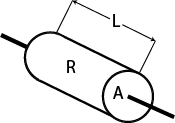This calculator calculates the resistivity of a component based on its resistance value, length, and cross-sectional area.
Output
Overview
Our resistivity calculator will help you calculate the resistivity of a material which is a function of its resistance value, length, and cross-sectional area.

Equation
$$\rho = \frac{RA}{L}$$
Where:
$$\rho$$ = resistivity of the material in ohm-m (Ω-m)
$$R$$ = resistance of the material in ohms (Ω).
$$L$$ = length of the material in meters (m).
$$A$$ = cross-sectional area of the material in square meters (m2).
The resistivity of a material is the amount of resistance it can offer to a current based on its dimensions. This is actually inherent to a specific material as each type has its own resistivity values. Normally, we calculate the resistance R of the material given its resistivity and dimensions.
From the formula above, it can be said that resistivity is directly proportional to the cross-sectional area of the material and inversely proportional to its length. This means that a material with a larger cross-section or a shorter length will have a higher resistivity value. Conversely, a material with a smaller cross-section or a longer length will have a smaller resistivity value. The resistance of the material is also a factor and is directly proportional to its resistivity.
Conductors tend to have low resistivity while insulators have high resistivity.
Conductivity, usually denoted by $$\sigma$$, is the reciprocal of resistivity, $$\sigma = \frac{1}{\rho}$$.
Notes
- The resistivity of graphene, a special carbon material, is 1 x 10-8 Ω-m
- The resistivity of Teflon, the one found in non-stick frying pans, is 1 x 1025 Ω-m
- Semiconductors have resistivities between that between of conductors and insulators
- The resistivity of a material is dependent on temperature. It can be calculated using the formula:
$$\rho = \rho_{0}[1 + \alpha(T - T_{0})]$$






0 Comments Login